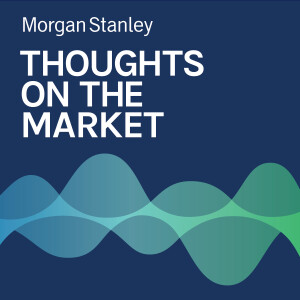
As markets adjust to global volatility, our Head of Corporate Credit Research considers when the Fed might choose to cut interest rates and how long the impacts may take to play out.
----- Transcript -----
Welcome to Thoughts on the Market. I'm Andrew Sheets, head of Corporate Credit Research at Morgan Stanley. Along with my colleagues bringing you a variety of perspectives, today I'll discuss the market’s expectation for much larger rate cuts from the Federal Reserve, and how much that actually matters.
It's Friday, August 9th at 2pm in London.
Markets have been volatile of late. One of the drivers has been rising concern that the Fed may have left interest rates too high for too long, and now needs to more dramatically course-correct. From July 1st through August 2nd, the market’s expectation for where the Fed’s target interest rate will be in one year’s time has fallen by more than 1 percent.
But…wait a second. We’re talking about interest rates here. Isn’t a shift towards expecting lower interest rates, you know, a good thing? And that seems especially relevant in the recent era, where strong markets often overlapped with fairly low interest rates.
Zoom out over a longer span of history, however, and that’s not always the case.
Interest rates, especially the rates from the Federal Reserve, are often a reflection of economic strength. And so high interest rates often overlap with strong growth, while a weak economy needs the support that lower rates provide. And so if interest rates are falling based on concern that the economy is weakening, which we think describes much of the last two weeks, it’s easier to argue why credit or equity markets wouldn’t like that outcome at all.
That’s especially true because of the so-called lag in monetary policy. If the Fed lowered interest rates tomorrow, the full impact of that cut may not be felt in the economy for 6 to 12 months. And so if people are worried that conditions are weakening right now, they’re going to worry that the help from lower rates won’t arrive in time.
The upshot is that for Credit, and I would say for other asset classes as well, rate cuts have only tended to be helpful if growth remained solid. Rate cuts and weaker growth were bad, and that was more true the larger those rate cuts were. In 2001, 2008 and February of 2020, large rate cuts as the economy weakened led to significant credit losses. Concern about what those lower rates signalled outweighed the direct benefit that a lower rate provided.
We think that dynamic remains in play today, with the market over the last two weeks suggesting that a combination of weaker growth and lower rates may be taken poorly, not taken well.
But there’s also some good news: Our economists think that the market's views on growth, and interest rates, may both be a little overstated. They think the US economy is still on track for a soft-landing, and that last week’s jobs report wasn’t quite as weak as it was made out to be.
Because of all that, they also don’t think that the Fed will reduce interest rates as quickly as the market now expects. And so, if that’s now right, we think a stronger economy and somewhat higher rates is going to be a trade-off that credit is happy to take.
Thanks for listening. If you enjoy the show, leave us a review wherever you listen and share Thoughts on the Market with a friend or colleague today.
More Episodes
 2024-10-11
2024-10-11
 2024-10-10
2024-10-10
 2024-10-09
2024-10-09
 2024-10-04
2024-10-04
 2024-10-03
2024-10-03
 2024-10-01
2024-10-01
 2024-09-30
2024-09-30
 2024-09-27
2024-09-27
 2024-09-25
2024-09-25
 2024-09-24
2024-09-24
 2024-09-19
2024-09-19
 2024-09-17
2024-09-17
 2024-09-16
2024-09-16
Create your
podcast in
minutes
- Full-featured podcast site
- Unlimited storage and bandwidth
- Comprehensive podcast stats
- Distribute to Apple Podcasts, Spotify, and more
- Make money with your podcast
It is Free
- Privacy Policy
- Cookie Policy
- Terms of Use
- Consent Preferences
- Copyright © 2015-2024 Podbean.com





